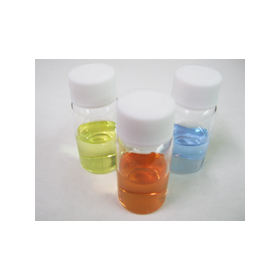It can be easily induced into compounds such as benzothiazole and can be used as a raw material for agrochemicals and pharmaceuticals.
"2-Aminothiophenol (2-Aminobenzenethiol)" is a building block that contains both nitrogen and sulfur atoms. It can be easily converted into compounds such as benzothiazole and can be used as a raw material for agrochemicals and pharmaceuticals. In addition to serving as a raw material for phthalocyanines with near-infrared absorption capabilities, it coordinates with zinc and forms complexes, making it effective as a raw material for blood glucose-lowering agents. 【Features】 ■ Contains both nitrogen and sulfur atoms ■ Serves as a raw material for functional phthalocyanines ■ Serves as a raw material for blood glucose-lowering agents ■ Acts as a metal surface treatment agent *For more details, please refer to the PDF document or feel free to contact us.
Inquire About This Product
basic information
【General Properties (Excerpt)】 ■Appearance: Yellow-brown liquid or solid with a peculiar odor ■Chemical Name: 2-Aminobenzenethiol ■Other Names: 2-Mercaptoaniline, ortho-Aminobenzenethiol ■Molecular Weight: 125.19 ■Boiling Point: 280 °C ■Melting Point: 19–21 °C ■Specific Gravity: 1.170 (25 °C) ■Solubility: Freely miscible with BTX compounds and alcohols, insoluble in water *For more details, please refer to the PDF document or feel free to contact us.*
Price range
Delivery Time
Applications/Examples of results
For more details, please refer to the PDF document or feel free to contact us.
catalog(1)
Download All CatalogsCompany information
Our company is a manufacturer that responds to the needs of various industries with synthetic technology related to sulfur compounds. With our unique technological capabilities, responsiveness, and expertise developed over many years, we flexibly and swiftly meet our customers' needs. Products created using the technologies we have developed (organic synthesis technology (thiochemical), high-pressure gas reaction technology, coupling reaction technology (Ullmann reaction), and emulsification technology) are widely used in the fields of electronics and information materials, pharmaceuticals and cosmetics, textiles, and the environment.








![Reasonable experimental table - Lab table for experiments [Video available]](https://image.mono.ipros.com/public/product/image/a12/2000642817/IPROS83593351681460979832.jpeg?w=280&h=280)
![[Domestic Stock] Adipic Acid・M [Free Sample Available]](https://image.mono.ipros.com/public/product/image/20f/2000770152/IPROS2963244921802048756.png?w=280&h=280)


